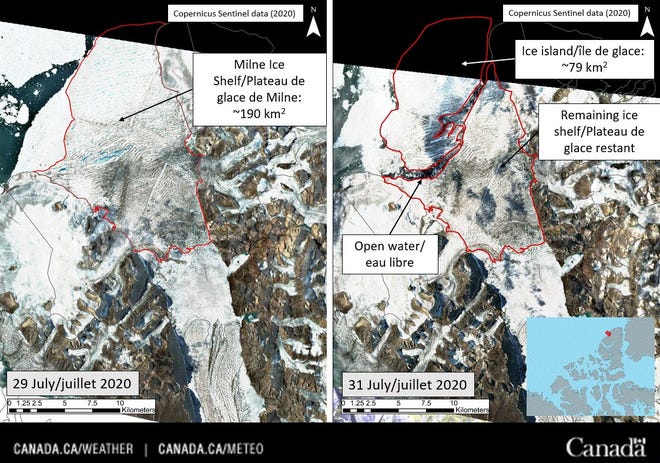'It’s disintegrated': Canada's
last intact Arctic ice shelf has
collapsed
The shelf’s area shrank by about 30 square miles due to the collapse.
The Arctic has been warming at a rate twice that of the rest of the world.
Two of Canada’s ice caps, located on the Hazen Plateau in St. Patrick Bay, disappeared completely this summer.
7 August, 2020
Canada's last intact ice shelf has collapsed, researchers announced Thursday.
A huge section of the Milne Ice Shelf, located on Ellesmere Island in the northern Canadian territory of Nunavut, collapsed into the Arctic Ocean, according to the Canadian Ice Service. This created an "ice island" that's about 30 square miles in size.
As a comparison, Manhattan Island is about 23 square miles.
“Entire cities are that size. These are big pieces of ice,” Luke Copland, a glaciologist at the University of Ottawa who was part of the research team studying the ice shelf, told Reuters. “This was the largest remaining intact ice shelf, and it’s disintegrated, basically.”
The ice service said on Twitter that “above-normal air temperatures, offshore winds and open water in front of the ice shelf are all part of the recipe for ice shelf break up.”

The ice shelf has now been reduced in area by about 43%.
An ice shelf is a thick slab of ice, attached to a coastline and extending out over the ocean, according to the National Snow and Ice Data Center. "Some shelves persist for thousands of years," the center said.
So what's going on up there? Though the planet is warming worldwide due to climate change, the Arctic has been warming at a rate twice that of the rest of the world, according to the National Oceanic and Atmospheric Administration. This summer has been particularly warm: Arctic sea ice melted to its lowest July level on record and in June, a town in Siberia soared to 100.4 degrees, believed to be a record high for the Arctic.
“When I first visited those ice caps, they seemed like such a permanent fixture of the landscape,” Mark Serreze, director of NSIDC and a geographer at the University of Colorado, Boulder, said in a statement. “To watch them die in less than 40 years just blows me away.”
More:The amount of Arctic sea ice melted away to a record low for the month of July



No comments:
Post a Comment
Note: only a member of this blog may post a comment.